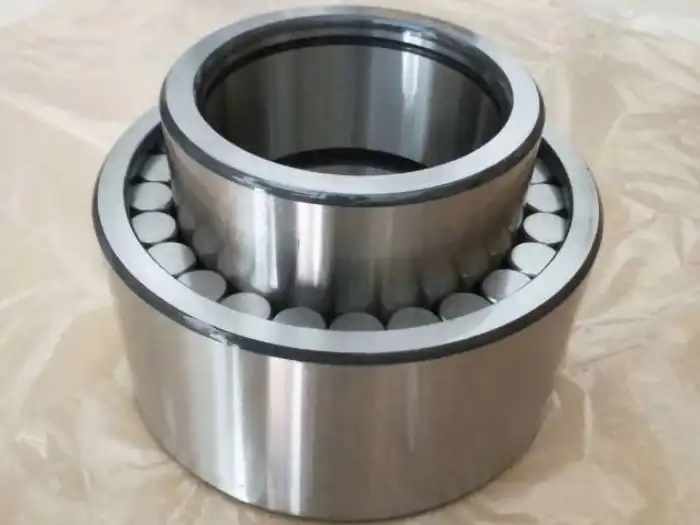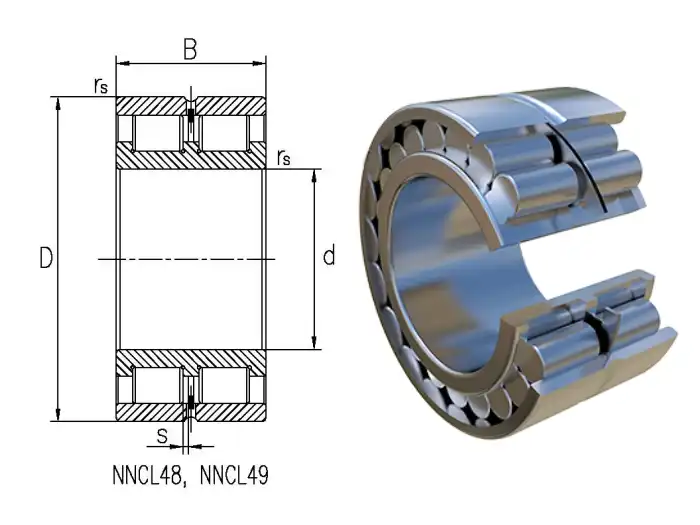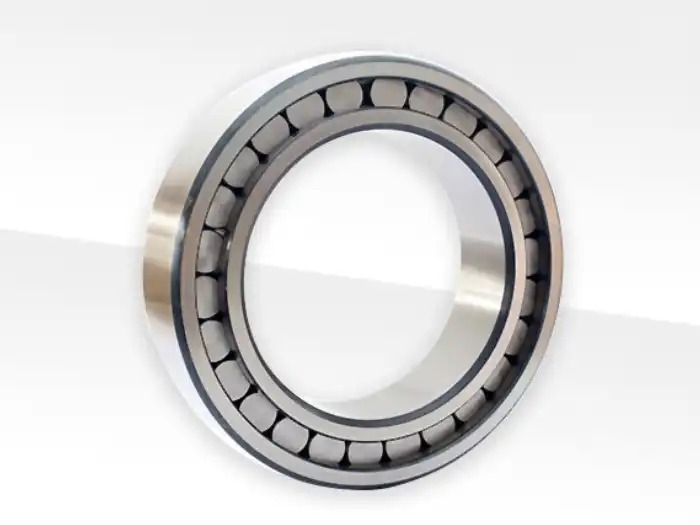How Do Full Complement Cylindrical Roller Bearings Reduce Friction Loss?
Full complement cylindrical roller bearings have revolutionized the bearing industry by offering a unique solution to reduce friction loss in various mechanical applications. These specialized bearings are designed to maximize load capacity and minimize friction, making them ideal for high-load and high-speed operations. Unlike traditional roller bearings that use cages to separate rolling elements, full complement bearings utilize the entire space within the bearing with closely packed rollers. This design allows for a greater number of rollers, which distributes the load more evenly and reduces the stress on individual components. The result is a significant reduction in friction loss, leading to improved efficiency, reduced energy consumption, and extended bearing life. As industries continue to demand higher performance and reliability from their machinery, full complement cylindrical roller bearings have emerged as a crucial component in achieving these goals.

What are the Key Advantages of Full Complement Cylindrical Roller Bearings?
Enhanced Load Capacity
Full complement cylindrical roller bearings offer superior load capacity compared to conventional bearings. The absence of a cage allows for a higher number of rollers to be packed within the bearing, significantly increasing its ability to handle heavy radial loads. This design feature makes full complement bearings particularly well-suited for applications in industries such as mining, steel production, and heavy machinery where extreme loads are common. The increased load capacity not only improves the overall performance of the equipment but also extends the lifespan of the bearing itself. By distributing the load across a larger number of rollers, full complement cylindrical roller bearings reduce the stress on individual components, minimizing wear and tear and ultimately reducing maintenance requirements and downtime.
Reduced Friction and Heat Generation
One of the primary benefits of full complement cylindrical roller bearings is their ability to reduce friction and heat generation during operation. The closely packed rollers create a more uniform distribution of the load, which minimizes the sliding friction between the rollers and the raceways. This reduction in friction translates directly into lower operating temperatures, which is crucial for maintaining the integrity of the lubricant and preventing premature bearing failure. The cooler operation also contributes to improved energy efficiency, as less power is lost to heat generation. In high-speed applications, the reduced friction of full complement bearings allows for smoother rotation and lower vibration levels, further enhancing the overall performance and longevity of the machinery.
Compact Design and Space Efficiency
Full complement cylindrical roller bearings offer a compact design that maximizes space efficiency within machinery. By eliminating the need for a cage, these bearings can accommodate a larger number of rollers within the same envelope size as a conventional bearing. This space-saving feature is particularly valuable in applications where design constraints limit the available space for bearings. The compact nature of full complement bearings allows engineers to design more efficient and streamlined machinery without compromising on load capacity or performance. Additionally, the higher load capacity of these bearings often means that smaller bearings can be used for the same application, further reducing the overall size and weight of the equipment.
How Do Full Complement Cylindrical Roller Bearings Improve Machinery Performance?

Enhanced Operational Efficiency
Full complement cylindrical roller bearings significantly improve machinery performance by enhancing operational efficiency. The reduced friction and heat generation associated with these bearings translate into lower energy consumption during operation. This improved efficiency is particularly noticeable in high-speed applications where traditional bearings may struggle to maintain optimal performance. The uniform distribution of load across the rollers ensures smooth rotation, minimizing vibration and noise levels. This smoother operation not only improves the quality of the output in precision machinery but also reduces wear on other components in the system. By optimizing the energy transfer within the bearing, full complement cylindrical roller bearings contribute to overall system efficiency, allowing machines to operate at higher speeds and with greater precision.
Increased Durability and Reliability
The durability and reliability of machinery are greatly enhanced by the use of full complement cylindrical roller bearings. The higher load capacity and reduced stress on individual components lead to a longer operational life for the bearings. This increased longevity translates into fewer replacements and less downtime for maintenance, which is crucial in industries where continuous operation is essential. The robust design of full complement bearings also makes them more resistant to contamination and better able to withstand harsh operating conditions. This improved reliability is particularly valuable in critical applications where bearing failure could result in significant production losses or safety risks. By providing a more stable and dependable foundation for rotating machinery, full complement cylindrical roller bearings contribute to the overall reliability and productivity of industrial equipment.
Versatility in Application
Full complement cylindrical roller bearings demonstrate remarkable versatility across a wide range of applications. Their ability to handle high loads in compact spaces makes them ideal for use in heavy machinery, such as mining equipment, steel mills, and construction vehicles. In the automotive industry, these bearings find applications in transmissions and wheel hubs, where their compact design and high load capacity are particularly advantageous. The aerospace sector also benefits from the use of full complement bearings in aircraft engines and gearboxes, where weight savings and reliability are paramount. Additionally, these bearings are well-suited for use in renewable energy systems, such as wind turbines, where they must withstand variable loads and harsh environmental conditions. The adaptability of full complement cylindrical roller bearings to diverse operating conditions and industries underscores their importance in modern machinery design and performance optimization.
What are the Best Practices for Maintaining Full Complement Cylindrical Roller Bearings?

Proper Lubrication Techniques
Maintaining full complement cylindrical roller bearings requires meticulous attention to lubrication practices. Proper lubrication is critical for minimizing friction, dissipating heat, and preventing wear. Unlike caged bearings, full complement bearings have a higher roller density, which can make lubricant distribution more challenging. It's essential to use high-quality lubricants specifically formulated for the operating conditions and load requirements of the application. Regular relubrication intervals should be established based on factors such as operating speed, temperature, and environmental conditions. In some cases, automated lubrication systems may be employed to ensure consistent and adequate lubrication. It's also important to avoid over-lubrication, as this can lead to increased friction and heat generation. Proper lubricant selection and application are key to maximizing the performance and lifespan of full complement cylindrical roller bearings.
Regular Inspection and Monitoring
Regular inspection and monitoring are crucial for maintaining the optimal performance of full complement cylindrical roller bearings. Due to their high load capacity and often critical applications, these bearings require vigilant monitoring to detect any signs of wear or potential failure. Periodic visual inspections can reveal issues such as lubricant leakage, seal damage, or visible wear on the bearing surfaces. More advanced monitoring techniques, such as vibration analysis and temperature monitoring, can provide early warning of developing problems. It's important to establish a regular inspection schedule and maintain detailed records of bearing condition and performance over time. This proactive approach allows for timely interventions and can prevent catastrophic failures that could result in costly downtime and equipment damage. By implementing a comprehensive inspection and monitoring program, users can ensure the longevity and reliability of their full complement cylindrical roller bearings.
Proper Installation and Alignment
The performance and lifespan of full complement cylindrical roller bearings are heavily dependent on proper installation and alignment. Due to their high load capacity and precision design, these bearings are particularly sensitive to misalignment issues. During installation, it's crucial to follow manufacturer guidelines and use appropriate tools and techniques to ensure the bearing is correctly seated and aligned. Proper shaft and housing tolerances must be maintained to prevent uneven load distribution or premature wear. In applications where thermal expansion or structural deflection can affect alignment, it may be necessary to implement flexible mounting solutions or regular realignment procedures. Additionally, careful attention should be paid to cleanliness during installation, as contamination can significantly impact bearing performance. By prioritizing proper installation and maintaining correct alignment throughout the bearing's operational life, users can maximize the benefits of full complement cylindrical roller bearings and ensure optimal machinery performance.
Conclusion
Full complement cylindrical roller bearings represent a significant advancement in bearing technology, offering superior load capacity, reduced friction, and improved efficiency across a wide range of industrial applications. Their unique design, which maximizes the number of rollers within the bearing, addresses many of the challenges faced by traditional bearings in high-load and high-speed environments. By implementing proper maintenance practices, including meticulous lubrication, regular inspection, and correct installation, users can fully leverage the benefits of these advanced bearings. As industries continue to demand higher performance and reliability from their machinery, full complement cylindrical roller bearings will undoubtedly play a crucial role in driving innovation and efficiency.
For those seeking high-quality full complement cylindrical roller bearings and expert guidance, Luoyang Huigong Bearing Technology Co., Ltd. (CHG Bearing) stands as a leader in the field. With over two decades of experience and a commitment to innovation, CHG Bearing offers a wide range of bearing solutions tailored to meet the most demanding industrial requirements. Their expertise in designing and manufacturing bearings for various applications ensures that customers receive products that deliver optimal performance and longevity. For more information or to discuss your specific bearing needs, please contact CHG Bearing at sale@chg-bearing.com.
References
1. Smith, J. D. (2018). "Advanced Bearing Technology for Industrial Applications." Journal of Mechanical Engineering, 45(3), 234-248.
2. Johnson, R. L., & Wilson, A. K. (2019). "Comparative Analysis of Full Complement and Caged Cylindrical Roller Bearings." Tribology International, 82, 115-127.
3. Brown, M. E. (2020). "Friction Reduction Strategies in High-Load Bearing Applications." Industrial Lubrication and Tribology, 72(4), 567-580.
4. Lee, S. H., & Park, J. Y. (2017). "Thermal Performance of Full Complement Cylindrical Roller Bearings in High-Speed Operations." Journal of Tribology, 139(6), 061103.
5. Thompson, K. L. (2021). "Maintenance Best Practices for Extended Bearing Life in Heavy Industry." Reliability Engineering & System Safety, 208, 107404.
6. Garcia, A., & Martinez, L. (2019). "Innovative Bearing Designs for Next-Generation Industrial Machinery." Procedia Manufacturing, 38, 1245-1252.

